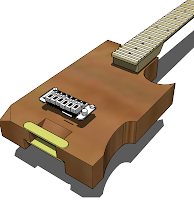 In the previous post, I described my intention of creating a playable testbed for experiments with different pickups. It turned out to be nice to play, so I improved it with a strap horn and the acrylic body from my t-beam bass. As it turned out, it was quite neck heavy. And since I prefer a headless guitar in most circumstances, I began to consider a tuner system down behind the bridge plus removing the headstock.
In the previous post, I described my intention of creating a playable testbed for experiments with different pickups. It turned out to be nice to play, so I improved it with a strap horn and the acrylic body from my t-beam bass. As it turned out, it was quite neck heavy. And since I prefer a headless guitar in most circumstances, I began to consider a tuner system down behind the bridge plus removing the headstock.The design - as many others - uses traditional tuners mounted at the end of the guitar. Most of the existing designs however, has the strings fan out from the bridge and onto the tuners. The tuners have a lot of distance between them in order to allow room for the fingers when tuning. One solution is a design using two rows of three tunes facing each other and sharing the same slot. For the latter, I bought a set of six twelve-string tuners (they have the pegs closer together than six string tuners, saving space).
The tuners are made from one side of the twelve string tuners, cut in half - i.e. 2 x 3 tuners. I found out that they had a nice copper coating beneath the crome, so I filed away some of the chrome. I hope, when the steel and copper oxidizes, that they will look more discreet. They seem to work decently, but I imagine that better quality tuners might improve the system somewhat.
The strings can be tuned easily and precisely. Mounting the strings is a bit troublesome, but will probably be easier when I've tried it a couple of times. Unfortunately, my soldering job was insufficient and the top plate broke off. When I re-soldered it (and bolted it too, to be on the safe side), I was too hasty, and the holes for the pegs didn't line up. I
If they keep working well, I'll cut the headstock off the neck, but for now I am anchoring the ball end of the strings in the existing tuner pegs on the headstock. I plan to play it for some time and make sure that it's a keeper (the overall design, not this particular version). I've got to be certain this works before chopping away.